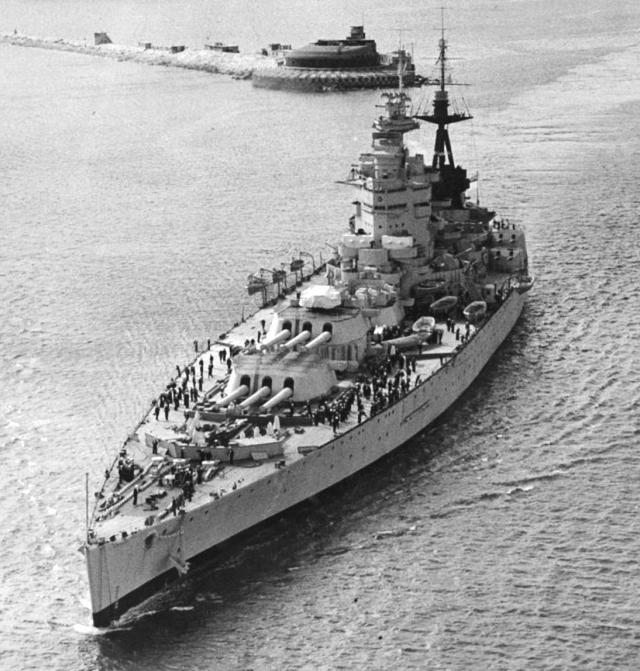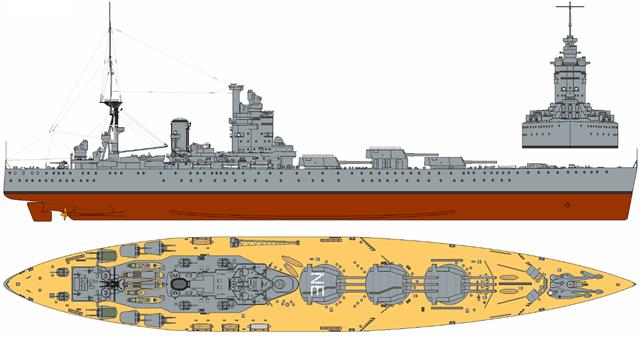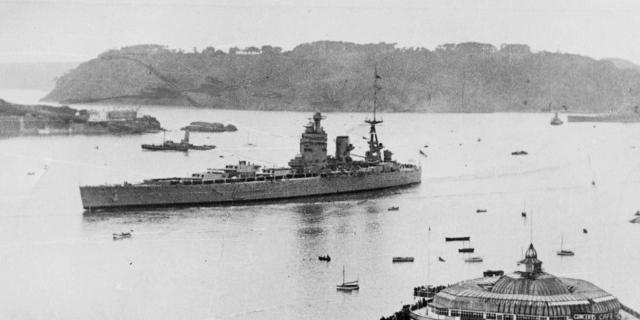November 23, 2010
The Misfit Battleships
When one thinks of battleships, what leaps to mind? The gleaming Iowas, usually. Others would think of the hulking Yamato-class, still the largest battlewagons ever built. Or perhaps the menacing Bismarck and Tirpitz, pride of the Kriegsmarine would hold primacy over all. If you have a sense of history, classes like the Nevada/Pennsylvania, with their cage masts and one of which, the Arizona, is now one of the US military's most hallowed sites. Or the first of them all, the Dreadnought.
And then there's me. I'm a weirdo, because my favorite battleship class is one that few people know or (historically) care about. You see, I'm a fan of the Nelsons.
I can hear you now: "The whichnow?" These:

The sharper-eyed amongst you have already noticed the obvious difference.
For those who aren't as skilled at the wildly esoteric art of turret spotting, allow me to make it clear:

That's right, HMS Nelson and HMS Rodney had their main armament entirely ahead of the superstructure... and therein lies a tale. Prior to the Washington Naval Treaty of 1922, the British Admiralty had a design on the table for a "superbattleship," called the N3-class. As designed, the N3s were to have nine 18" rifles in three turrets, weigh nearly 50000 tons each and steam at 23kts. It was to have heavy protection in exchange for speed. Paired with a matching battlecrusier design called the G3, which emphasized speed (32kts) over armor, was to carry nine 16" guns, and have the same displacement as the N3, the two types were to form the backbone of the Royal Navy for decades.
Then the Washington Naval Treaty came along and changed everything. Suddenly, battleships were limited to a maximum displacement of 35000 tons and 16" guns, rendering the N3s illegal with a single stroke of the pen. The G3, which was a faster, down-gunned and -armored N3, wasn't even close to being viable, so it went into the trash.
But the Royal Navy had a problem. Much of its fleet was worn out after WWI, and many of those that weren't were obsolescent due to newer, more advanced designs from Japan and America which shipped heavier armament, better armor, and more powerful propulsion. It needed new battleships if it was to hold onto the title of the world's most powerful navy (and not coincidentally, hold onto the globe-spanning empire that was the United Kingdom), and it needed them soon. Germany had been defeated, it's true, but it wasn't beaten, no matter what the politicians said. It needed new battleships, and their best design had just been turned into nothing more than a nice fantasy.
Then some bright spark at the Admiralty came up with an idea. Why not use the N3 design anyway? Just run it through the wash, throw it in a hot dryer for a few hours, and voila, a battleship that would come in just under the displacement limits! Everybody declared this concept brilliant and the Nelsons were born. Like the N3, the main armament was in three triple turrets forward instead of the RN-standard four dual-gunned turrets, the superstructure more-or-less triangular with the secondary battery arranged around it, the powerplant driving two shafts instead of the more traditional four.

Laid down in 1922, launched in 1925, and commissioned in 1927 (Rodney) and 1930 (Nelson), the ships weighed in at just shy of 34000 tons and were the first "Treaty Battleships." Humorously, they were known in the Royal Navy as the "Cherry Tree" class, since they were the design "cut down by Washington."
With a nearly 16000 ton weight reduction, they should have been quite fast, but to keep the level of protection high the original N3 machinery was cut down as well. As a result, the Nelsons top speed was 23.5kts, just a smidge over that of the original design. Gone too were the massive 18" guns, replaced by the 16" rifles intended for use in the G3 design. Interestingly, these were the only ships in RN history to ship 16" guns, 14" and 15" being more common.
Armor was positioned on the American "all or nothing" concept instead of the RN's habit of creating armored boxes at various points of the ship with lighter "bursting plates" high up. These bursting plates were designed to cause incoming heavy shells to begin exploding before they penetrated deeply into the ship, where the armored boxes would deflect the explosive forces away from vital areas. The all or nothing design on the other hand would either defeat the shell entirely, or it wouldn't. As shown by the US Navy's experience, all-or-nothing was generally more successful than the armored box concept, but that's a discussion for another day with someone who knows more about that sort of thing than myself.

As it turned out, the Nelsons did indeed become the backbone of the Royal Navy in the time between the wars, but not in the way that was planned. They were the only new battleships laid down by the RN between 1916 (the Revenge-class, later rebuilt to become the Renown-class battlecruisers) and 1940 (the King George V-class), thereby becoming the main ships of the fleet by default.
Both ships had an active time of it in World War II. The Rodney was involved in the hunt for the Bismarck, and her 16" guns caused terrible damage to the German ship. Indeed, once the Bismarck's guns were disabled, Rodney came close enough to fire on essentially a flat trajectory. At that point, one 16" round was seen to hit the front armor of Bismarck's "B" turret, punch through its 14" thick armor, and blow out the back of the turret. She went on to serve in the Mediterranean, as part of Operation Torch (the invasion of North Africa), on the Murmansk convoy route, and finally as part of the bombardment force at D-Day. She was so busy, in fact, that she sailed nearly 160000 miles between overhauls from 1942 and the end of 1944. Her machinery tired and worn, she was put into reserve at Scapa Flow and her crew placed aboard other ships.
The Nelson on the other hand was a damage magnet. Over the course of her career, she ran aground once, hit three mines, took three German torpedoes in one submarine attack (none of which exploded), and was crippled by a Regia Aeronautica torpedo plane. Perversely, because of all this damage she was regularly upgraded and improved, unlike the Rodney. She too served during Operation Torch, was part of the bombardment force at Salerno, and was the site of the signing of the Italian Armistice. She was at Normandy, but there she hit two mines and was laid up for repairs. After those were completed, she was sent to the Indian Ocean, where she was the site of the Japanese surrender of Malaysia. When she returned to Britian, she was made the flagship of the Home Fleet.
Both the Nelson and Rodney were scrapped in 1949, bringing to an end the careers of two misfit battleships that nevertheless turned out to be amongst the most successful in Royal Navy history.

Is it any wonder that they're my favorite?
Comments are disabled.
Post is locked.
And then there's me. I'm a weirdo, because my favorite battleship class is one that few people know or (historically) care about. You see, I'm a fan of the Nelsons.
I can hear you now: "The whichnow?" These:

The sharper-eyed amongst you have already noticed the obvious difference.
For those who aren't as skilled at the wildly esoteric art of turret spotting, allow me to make it clear:

That's right, HMS Nelson and HMS Rodney had their main armament entirely ahead of the superstructure... and therein lies a tale. Prior to the Washington Naval Treaty of 1922, the British Admiralty had a design on the table for a "superbattleship," called the N3-class. As designed, the N3s were to have nine 18" rifles in three turrets, weigh nearly 50000 tons each and steam at 23kts. It was to have heavy protection in exchange for speed. Paired with a matching battlecrusier design called the G3, which emphasized speed (32kts) over armor, was to carry nine 16" guns, and have the same displacement as the N3, the two types were to form the backbone of the Royal Navy for decades.
Then the Washington Naval Treaty came along and changed everything. Suddenly, battleships were limited to a maximum displacement of 35000 tons and 16" guns, rendering the N3s illegal with a single stroke of the pen. The G3, which was a faster, down-gunned and -armored N3, wasn't even close to being viable, so it went into the trash.
But the Royal Navy had a problem. Much of its fleet was worn out after WWI, and many of those that weren't were obsolescent due to newer, more advanced designs from Japan and America which shipped heavier armament, better armor, and more powerful propulsion. It needed new battleships if it was to hold onto the title of the world's most powerful navy (and not coincidentally, hold onto the globe-spanning empire that was the United Kingdom), and it needed them soon. Germany had been defeated, it's true, but it wasn't beaten, no matter what the politicians said. It needed new battleships, and their best design had just been turned into nothing more than a nice fantasy.
Then some bright spark at the Admiralty came up with an idea. Why not use the N3 design anyway? Just run it through the wash, throw it in a hot dryer for a few hours, and voila, a battleship that would come in just under the displacement limits! Everybody declared this concept brilliant and the Nelsons were born. Like the N3, the main armament was in three triple turrets forward instead of the RN-standard four dual-gunned turrets, the superstructure more-or-less triangular with the secondary battery arranged around it, the powerplant driving two shafts instead of the more traditional four.

Laid down in 1922, launched in 1925, and commissioned in 1927 (Rodney) and 1930 (Nelson), the ships weighed in at just shy of 34000 tons and were the first "Treaty Battleships." Humorously, they were known in the Royal Navy as the "Cherry Tree" class, since they were the design "cut down by Washington."
With a nearly 16000 ton weight reduction, they should have been quite fast, but to keep the level of protection high the original N3 machinery was cut down as well. As a result, the Nelsons top speed was 23.5kts, just a smidge over that of the original design. Gone too were the massive 18" guns, replaced by the 16" rifles intended for use in the G3 design. Interestingly, these were the only ships in RN history to ship 16" guns, 14" and 15" being more common.
Armor was positioned on the American "all or nothing" concept instead of the RN's habit of creating armored boxes at various points of the ship with lighter "bursting plates" high up. These bursting plates were designed to cause incoming heavy shells to begin exploding before they penetrated deeply into the ship, where the armored boxes would deflect the explosive forces away from vital areas. The all or nothing design on the other hand would either defeat the shell entirely, or it wouldn't. As shown by the US Navy's experience, all-or-nothing was generally more successful than the armored box concept, but that's a discussion for another day with someone who knows more about that sort of thing than myself.

As it turned out, the Nelsons did indeed become the backbone of the Royal Navy in the time between the wars, but not in the way that was planned. They were the only new battleships laid down by the RN between 1916 (the Revenge-class, later rebuilt to become the Renown-class battlecruisers) and 1940 (the King George V-class), thereby becoming the main ships of the fleet by default.
Both ships had an active time of it in World War II. The Rodney was involved in the hunt for the Bismarck, and her 16" guns caused terrible damage to the German ship. Indeed, once the Bismarck's guns were disabled, Rodney came close enough to fire on essentially a flat trajectory. At that point, one 16" round was seen to hit the front armor of Bismarck's "B" turret, punch through its 14" thick armor, and blow out the back of the turret. She went on to serve in the Mediterranean, as part of Operation Torch (the invasion of North Africa), on the Murmansk convoy route, and finally as part of the bombardment force at D-Day. She was so busy, in fact, that she sailed nearly 160000 miles between overhauls from 1942 and the end of 1944. Her machinery tired and worn, she was put into reserve at Scapa Flow and her crew placed aboard other ships.
The Nelson on the other hand was a damage magnet. Over the course of her career, she ran aground once, hit three mines, took three German torpedoes in one submarine attack (none of which exploded), and was crippled by a Regia Aeronautica torpedo plane. Perversely, because of all this damage she was regularly upgraded and improved, unlike the Rodney. She too served during Operation Torch, was part of the bombardment force at Salerno, and was the site of the signing of the Italian Armistice. She was at Normandy, but there she hit two mines and was laid up for repairs. After those were completed, she was sent to the Indian Ocean, where she was the site of the Japanese surrender of Malaysia. When she returned to Britian, she was made the flagship of the Home Fleet.
Both the Nelson and Rodney were scrapped in 1949, bringing to an end the careers of two misfit battleships that nevertheless turned out to be amongst the most successful in Royal Navy history.

Is it any wonder that they're my favorite?
Posted by: Wonderduck at
10:23 PM
| Comments (2)
| Add Comment
Post contains 1199 words, total size 9 kb.
1
Dang, got me. I didn't spot that 3rd turret in the first photo. I realize they'll never build battleships again despite the wishes of some of the old boys in the US Marine Corp, but sometimes I play a mental fantasy about how and what it would take to build a modern equivalent for shore bombardment.
Posted by: toadold at November 24, 2010 12:57 AM (aErmb)
2
Who knows; perhaps the Nelsons will get the Yamato treatment someday. It happens more often than you'd think.
Posted by: Ben at November 24, 2010 07:15 PM (gze3w)
31kb generated in CPU 0.058, elapsed 0.4749 seconds.
47 queries taking 0.468 seconds, 278 records returned.
Powered by Minx 1.1.6c-pink.
47 queries taking 0.468 seconds, 278 records returned.
Powered by Minx 1.1.6c-pink.









